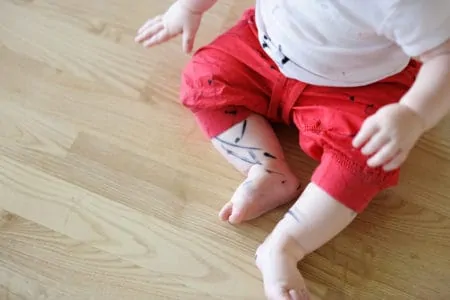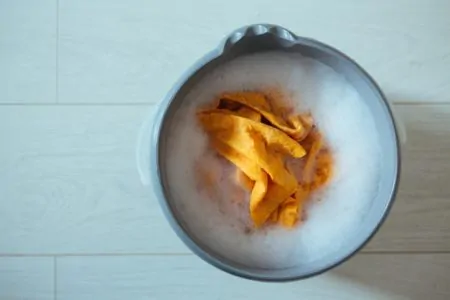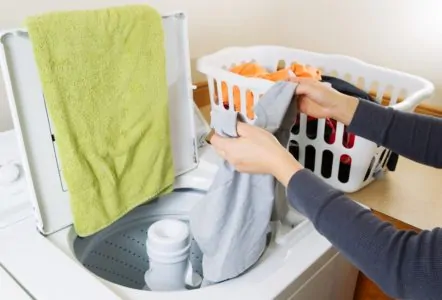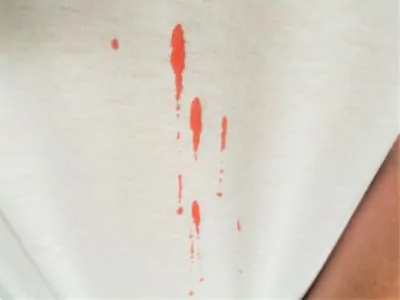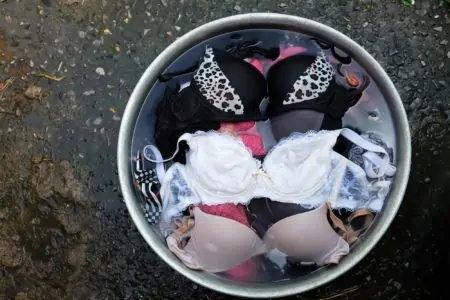There’s not much more frustrating on laundry day than when you notice an ink stain in your clothes. Whether you’ve had a pen leak, got a bit carried away while sketching a picture, or dropped your pen while journaling in bed — we can help.
We’ll teach you how to get ink out of clothes using seven different methods. Each method uses common household items. Just make sure to tackle the stain before washing and drying the garment, or the stain could set forever.
Key Takeaways
- Tackle ink stains as soon as possible and use household items like vinegar, cornstarch, rubbing alcohol, or hairspray.
- Identify the type of ink (water-based or oil-based) and choose the appropriate method for removing the stain.
- Always test your chosen solution on an inconspicuous area of the garment to avoid damaging the fabric or colors.
- Don’t dry the garment until the stain is completely removed, as heat can set the stain permanently.
Why Does Ink Stain Clothes?
Ink is typically made with pigments, dyes, and oils (1). These can discolor clothing and seep into the fibers, making it pretty difficult to remove — especially, after it’s dried.
Often, even if you’ve removed the dye, you still need to deal with the oil stain. But with our tips, there’s no need to worry.
What to Know About Removing Ink Stains From Clothing
Before we get started, here are some basics for removing ink stains. These apply no matter what method you choose:
Ink Stain Removal Basics
- Tackle ink stains as soon as you notice them.
- Keep the stain isolated. Don’t soak the entire garment, or the ink stain could bleed.
- Dab and blot at the stain first. You can scrub once the stain is lifted, but initially, dab or blot to lift the stain.
Water-Based Ink vs Oil-Based Ink
Water-based ink is typically found in washable markers and rollerball pens. It’s the easiest ink stain to remove and can usually be done with a bit of water and detergent. However, all our tips should work for water-based ink stains.
Oil-based ink, on the other hand, dries fast and is difficult to remove. It’s commonly found in ballpoint pens. The best way to remove oil-based ink stains is with an alcohol or glycerin-based product.
Take Note
Removing Ink Stains From Different Fabrics
It matters whether you’re dealing with cotton, linen, wool or synthetic materials. For each fabric, you might have to adjust your method slightly.
First, always read the care label to see the recommended water temperature and if it can be washed at home. If it says dry clean only, it’s best to take it to the dry cleaners.
Next, you should always use a method that is safe for that garment. For example, don’t use a normal detergent on a wool item. You should use a special wool-safe detergent, or switch to a more gentle method.
Lastly, always test your chosen solution in an inconspicuous area of the garment before removing the ink stain. This allows you to ensure there is no damage to the fabric or the colors.
How to Get Ink Out of Clothing
The time is here! If you have an urgent ink stain, we have a few different options to choose from. Some work better than others; while some are best for certain fabrics. We’ll let you know if the tip is best for oil- or water-based stains and if it’s safe on all fabrics. Let’s get rid of that ink stain!
Take Note
Using Rubbing Alcohol
This is an amazing tip for oil-based ink stains, as alcohol-based products are the most effective. But it works for water-based stains, too.
Rubbing alcohol is quite harsh, so it can be damaging to synthetic or delicate materials, such as rayon, wool and silk. Always check in an inconspicuous area, especially on colored garments.
- Place the stained garment on top of a clean white towel.
- Test the rubbing alcohol in an inconspicuous spot.
- Pour a little bit of rubbing alcohol onto a clean white cloth. Blot the stain repeatedly until the ink starts to lift.
- Add a little bit more rubbing alcohol and let it sit for five minutes.
- Blot the stain again with a clean area of your cloth. Repeat until the stain is gone.
- Rinse the area with cold water.
- Only tumble dry the garment if the ink stain is gone.
Using Stain Removers
If you have a stain remover in the cupboard, put it to use on oil- or water-based stains. If it’s alcohol-based, it should work well with oil-based stains but read the ingredients to be sure. Also, check the packaging to check which garments it’s safe with.
You may need to adjust the instructions according to the manufacturer’s advice, but in general, you can follow these steps:
- Lay the garment on top of a clean white towel.
- Soak the stained area in cold water
- Apply your chosen stain remover to the stained area.
- Gently rub it into the fabric with a cloth or soft-bristled brush.
- Let it stand for between five and 30 minutes, depending on packaging instructions.
- Rinse the area. If the stain is gone, wash as normal. If it persists, repeat the process or try a different method.
Always Test First
Using Glycerin
Glycerin is a great choice for oil-based ink stains. We recommend glycerin for cotton and polyester items, but spot test for all fabrics. It does work on washable wool and silk items, too. Just make sure to dab instead of rub. Don’t rinse away the suds; instead, keep dabbing until the area is clean.
- Lay the garment on top of a clean white towel.
- Soak the stain in cold water.
- Apply the glycerin and let it sit for 10 minutes.
- If possible, add mild laundry detergent to the stain.
- Gently blot the stained area until it suds up.
- Rinse off with lukewarm water. If using on wool or silk, dab with a wet cloth until the suds are gone.
- Machine wash as normal if the stain is gone.
Using Dish Soap / Laundry Detergent
If your dish soap or laundry detergent is alcohol-based, this works on both oil- and water-based stains. If not, use this for water-based ink stains. Dish soap is safe on all fabrics, but check the manufacturer advice for your specific laundry detergent brand. As always, test in an inconspicuous area first.
- Lay the garment on top of a clean white towel.
- Blot the stain with a clean white wet cloth until the stain begins to transfer. Keep in mind this can damage your cloth, but hey — what are cloths for? Cleaning up messes!
- Add a teaspoon of dish soap or laundry detergent to the stain. Add more if the stain is bigger.
- Let it sit for five minutes.
- Gently scrub the detergent in.
- Rinse under lukewarm water.
- Check if the stain is gone. If not, repeat the process. If it’s gone, wash and dry as normal.
Using Hairspray
We love this tip in our house! If using an alcohol-based hairspray, we find that this works every single time. It’s great for oil-based and water-based ink stains. Always test in an inconspicuous area first as alcohol can be too harsh on delicate fabrics.
- Lay a clean white towel underneath the garment.
- Spray the stain with hairspray.
- Use a clean white cloth to blot the stain, lifting up as you go.
- Reapply the hairspray as needed.
- Wash and dry as normal once the stain is gone.
Using Vinegar and Cornstarch
Vinegar and cornstarch are gentle, natural ingredients, so they work on all fabrics. This is most effective on water-based stains, but you can try it on oil-based stains, too. However, oil-based stains generally need something a bit more powerful.
- Lay the stained garment on a clean white towel.
- Soak the ink stain in distilled white vinegar.
- Create a paste with two parts vinegar and three parts cornstarch. Mix together.
- Cover the stain in the paste and let it sit until completely dry.
- Rinse the area with lukewarm water.
- If the stain is gone, wash and dry the garment as normal. If it remains, repeat the process or try a different method.
Using Milk
Our last tip is milk! If that’s the only thing you have to hand, it can work to remove water-based ink stains. It is gentle on most fabrics, but always test in an inconspicuous area and be ready to wash the garment with an odor-fighting detergent afterwards.
- Fill a shallow bowl with milk.
- Put the stained area of the garment into the milk bowl, submerging it in the liquid.
- Let it sit overnight.
- Rinse it with lukewarm water. If necessary, repeat the process.
- If the stain is gone, wash and dry as normal.
Pro Tip
How to Get Pen Ink Out of Clothes After Drying
Do you have an ink stain that is already set into your clothes? Perhaps you didn’t notice the stain until after laundry day. What should you do?
Of course, if the garment is white, you could bleach it. But not every fabric can handle bleach, and some households don’t even use bleach. Instead, follow these tips:
- Pre-treat the stain with a stain remover. This is more effective if the stain remover has surfactants which can break up the oil. Always remember to spot test the stain remover in an inconspicuous area.
- Let the stain remover sit for 15 minutes.
- Hand wash the garment in lukewarm water with laundry detergent.
- Soak a cotton ball or cloth in rubbing alcohol, nail polish remover, hairspray or alcohol-based hand sanitizer.
- Dab the stained area until the stain is completely removed.
- Rinse the spot with cold water.
- Wash and dry as normal if the stain is gone.
How to Get Printer Ink Out of Clothes
Printer ink is super concentrated and oil-based. So it’s best to use our rubbing alcohol or hairspray tip.
If that doesn’t work, try the dish soap and detergent soap in combination with an alcohol-based product. Then wash in cold water with detergent once the stain is mostly removed. Never dry until the stain is completely removed.
FAQs
Seven Great Methods
In conclusion, we have seven amazing methods to remove water or oil-based ink stains from your clothing.
Remember to always test in an inconspicuous spot, choose the right method for your ink type and never dry the garment unless the stain is completely gone.
Overall, acting fast is the best way to tackle these ink spills.
